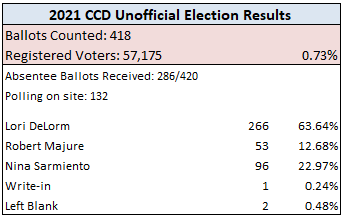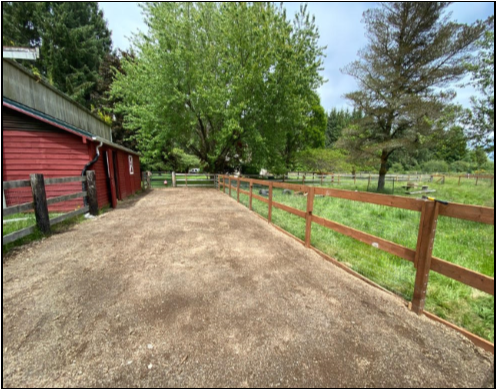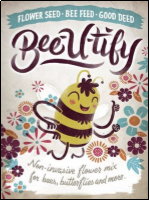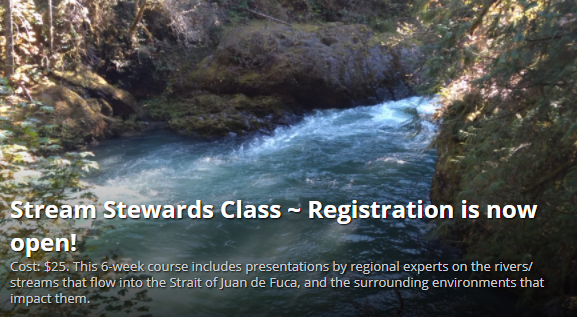2021 Election Results
The 2021 Clallam Conservation District Board of Supervisor Election results are in. Lori DeLorm is the unofficial winner, receiving over 63% of the votes.
The election included both absentee and in-person voting, the latter conducted on March 19. Conservation district elections results are unofficial until they are reviewed and certified by the Washington State Conservation Commission, which occurs during their May board meeting.
We can all probably agree, 2020 was a year to forget. The COVID19 pandemic presented crises, challenges and heartbreak not seen in our lifetimes. But we persevered.
At the conservation district, we adapted. Staff had the good fortune to be able to continue working, albeit mostly from home. We learned how to use Zoom and other online platforms for virtual meetings and workshops, but we truly missed getting out into the field and interacting directly with the people we serve. We directed our focus on our core mission of helping people practice better stewardship of our natural resources. What follows is a summary of our major accomplishments for this year to forget.
Although not an actual conservation accomplishment, perhaps our most significant achievement was securing stable funding that will provide us with a solid foundation to continue our conservation work. Thanks to the Clallam County Board of Commissioners, and Commissioner Johnson in particular, we now can expect to receive $125,000 annually from the County for the next four years. This is an increase from $26,000 that we had received for the past two decades (with the exception of 2019 when we received an additional $20,000). Knowing we will receive these funds over the next four years not only gives us peace of mind, it allows us to direct more of our time and effort toward getting actual work done.
Expenditures for 2020 totaled $1,440,956. State grants comprised 88 percent of revenues, and conservation practice implementation (not including staff time) accounted for 75 percent of expenditures.
Our focus was on water, fish and wildlife habitat, and soil, with the following specific objectives:
Reduce Water Use
Improve and Protect Water Quality
Enhance and Restore Fish and Wildlife Habitat
Conserve Farmland and Forestland
Continue reading as we take a closer look at how we tackled these conservation objectives.
Reduce Water Use
Irrigation piping projects reduce water loss from leaky ditches, while eliminating potential contamination. This allows more water to remain in the beautiful Dungeness River to help fish during low summer flows.
Most of our efforts to reduce water use have focused on big-ticket water conservation projects with the Dungeness irrigation districts and companies, most notably, piping leaky irrigation ditches. In 2020 we completed the piping of the Sequim Prairie-Tri Irrigation Association’s Evans Road lateral. This project totaled over 10,000 feet of piped ditch, nearly 3,000 feet of shallow aquifer recharge system, and Dungeness River water savings of 1.5 cubic feet per second during late summer. We also partnered with the Agnew Irrigation District on the piping of three of their laterals, one of which was completed in 2020.
We continued partnering with a diverse group of stakeholders to develop plans and secure funding for the Dungeness Off-Channel Reservoir. This project will result in substantial reductions in irrigation water diversions from the Dungeness River during the last four to six weeks of the irrigation season when river flows are low and irrigation water demand is high.
Also, in the Dungeness watershed, we’ve been managing the distribution of meters under a pilot project for the Dungeness Water Rule area. In 2020 we distributed 47 meters for new water mitigation certificate holders.
We worked with two farmers to develop irrigation water management plans to help them use irrigation water more efficiently.
In the outreach and education arena, we gave two presentations specifically about water use and conservation (85 participants), five workshops on sustainable landscaping (165 participants), and seven newsletter articles. Our sustainable landscaping education program promotes a variety of resource conservation objectives, including water conservation, habitat enhancement, and stormwater management.
Conserve Farmland and Forestland
Our activities in this area in 2020 were limited mostly to a series of 15 weekly noxious weed alert articles published on Facebook and posts during the spring and summer in our monthly eNewsletter. We also processed soil tests and provided support for the passage of the Conservation Futures program, which will generate revenue for the purchase of development rights on farmland.
Enhance and Restore Fish and Wildlife Habitat
Our habitat activities are focused on restoration of riparian habitat for salmon and addressing impacts from forest roads, including fish passage barriers and road related erosion and sedimentation.
In 2020 we oversaw the planting of 0.7 miles of riparian buffers along the Elwha River, Little River and Ennis Creek, maintenance of nine previously planted riparian sites. We also worked to secure funding for Forest Service road drainage upgrades in the Sitkum basin.
A deteriorating culvert on the Forest Service 2900 Road in Forks, located on a tributary to the Sitkum River. This culvert’s deteriorating condition poses a risk to washing out the road, which would deliver huge amounts of sediment into the Sitkum River, harming fish.
In 2020 we secured funding to design three culvert upgrades on this road system. In 2017 we worked on a similar project involving five other culverts, two of which have already been replaced. Two more are scheduled for replacement this summer.
Volunteers during our Orca Recovery Day planting event.
We partnered with the Lower Elwha Klallam Tribe on several COVID-safe volunteer events in 2020 that resulted in the planting of 2,479 trees and shrubs on the Elwha River, Little River and Ennis Creek.
Thank you to the 86 volunteers that logged a total of 220 hours!
If you are interested in volunteering, please Click HERE sign-up for our volunteer mailing list
Information and technical assistance was provided to 89 individuals throughout the county on topics such as habitat, native plant landscaping, forestry, critical areas, soils, and drainage. And as mentioned previously, the sustainable landscaping educational programs address these topics, too. We also sold 26,150 native trees and shrubs to 425 individuals. It’s so great to see all these native plants being put to use in landscapes, forests and riparian areas!!!
Improve and Protect Water Quality
We have two primary water quality focus areas: helping homeowners repair failing septic systems and helping horse and livestock owners implement best management practices. Our ultimate goals are safe and healthy shellfish growing areas (surface water) and drinking water (groundwater).
Onsite Septic System (OSS) Repair Program
Soil testing helps inform decisions about nutrient (fertilizer) application timing and amounts, which in turn can help protect both surface and ground water quality.
In 2020 we helped three homeowners repair failing septic systems – two near Dungeness Bay and one on a tributary to Bell Creek. Since its creation in 2014, this program has provided financial assistance to 19 homeowners to help repair or replace failing onsite septic systems impacting water quality. The geographic focus areas are the current Pollution Identification & Correction (PIC) activity areas.
Agricultural Water Quality
For agricultural water quality, our focus has been on the Dungeness-Sequim Bay Clean Water District; however, we provided assistance throughout Clallam County, for both surface water and groundwater improvement and protection.
Fencing horses and livestock from waterways helps prevent contamination of water from manure and sediment. Maintaining a filter strip of vegetation between the fence and waterway helps filter out nutrients and bacteria from animal manure that may run off pastures.
We provided technical assistance to five horse and livestock owners to implement six practices that improve/protect surface water quality. Those practices included fencing (725 total feet) to exclude access to surface water on five properties and heavy use area protection on one property.
For groundwater improvement/protection, we helped six horse owners install heavy use area protection. Two horse owners installed waste storage structures and one installed a roof runoff collection system. Thirty-five soil tests were processed for 20 properties.
We conducted six horse and livestock land and water stewardship workshops (225 participants), and published ten articles in our newsletter. We helped seven horse and livestock owners develop holistic conservation plans to address natural resource concerns, including water quality. Countywide, we provided information and technical assistance to 19 commercial livestock farms, 38 non-commercial livestock farms, and 19 non-livestock farms in 2020.
This gravel heavy use area was constructed in Forks for a farm with a horse and goats. A gravel heavy use area is an integral part of farms, enabling animals to be taken off wet pastures in the winter when grass plants are dormant and can’t utilize nutrients in manure. And, manure can be collected for proper storage, thus helping to protect water quality.
WEED WATCH: Poison Hemlock
Spring showers bring more than May flowers! Walk your property now to identify new infestations of poison hemlock, as well as other weeds, before they mature and flower.
Poison hemlock is extremely toxic! It is often found on poorly drained soils, particularly near streams, ditches, and other surface water. It also grows alongside roads, edges of cultivated fields, and vacant areas. All parts of this plant can kill humans and animals, even when dried, and it can easily be mistaken for more benign members of the carrot or parsley family.
Early growth includes clusters of lacey-like leaves on the ground surface. Mature plants can grow up to 12 feet in height, and often stalks from the previous year my still remain standing to help with identification. It has strong, smooth stems with purple splotches, and white flowers in 4 to 8 inch umbrella shaped clusters.
To control, pull out, bag up and dispose of all dead plant material at the landfill. Wear gloves while handling this plant. Mowing and cutting this plant is not effective.
Conservation Reserve
Enhancement Program (CREP)
CREP is an incentive program that helps landowners restore riparian habitat along salmon-bearing streams, as well as wetlands and ditches connected to salmon-bearing streams. All of the costs of planting trees and shrubs are covered by the program, and landowners receive a rental payment for the land enrolled in the program.
Fencing to exclude livestock from riparian areas and waterways is also eligible for funding as part of buffer planting, as is alternative stock watering systems for livestock affected by fencing.
CREP is a federal-state-local partnership program delivered to landowners through local conservation districts.
If you have a river or stream on your property, contact us for more information and a no-obligation site visit.
Washington Conservation Corps (WCC) crew members help us maintain Conservation Reserve Enhancement Program (CREP) riparian restoration projects. They plant trees and shrubs, control competing vegetation, and res-install tree protectors knocked over by wind, snow and wildlife.
A huge thanks goes out to this hardworking crew who have helped us plant and maintain over 10 miles of CREP riparian buffers over the years.
Horse & Livestock Workshops
We’re working on some exciting educational events for this summer and fall. Click HERE to sign-up for our horse and livestock email list. We will notify you of upcoming educational events and publications.
We also have created a collection of recorded webinars over the past few months on topics such as poultry keeping, pasture management, weed management, creating gravel heavy use areas, soil testing and more.
Forest & Wildlife Webinars
In partnership with the State Department of Natural Resources, we started a webinar series this year on a variety of forestry and wildlife topics. Our next presentation is:
Birdscaping, Part II
Wednesday, April 28, 2021 from 3:00 to 4:00 p.m.
Carolyn Wilcox will build on her previous week’s presentation and teach participants how to create better shelter and space for native birds, including information on the importance of snags and dead trees. Topics will also include detailed nest box design, incorporating bird habitat into landscape planning, and impacts of noxious weeds on wild birds.
(Part 1 - “Introduction to Birdscaping”, took place on April 21st click below to view)
Forest Insects & Diseases
Wednesday, May 12, 2021 from 3:00 to 4:00 p.m.
Glenn Kohler, Forest Entomologist for the WA Department of Natural Resources, will cover identification and management of common insects and pathogens that may cause damage to forest trees. The focus will be on pests that primarily affect young forest trees, including Douglas fir, Sitka spruce, western red cedar, grand fir, shore pine, and some broadleaf trees.
During registration you can choose to receive a recording of the event if you are unable to attend the live webinar. Below are details for a few of the upcoming webinars in the series. We’re in the process of adding more guest speakers so please check back!
Free Bee-U-Tify Seed Packets
The Washington State Noxious Weed Control Board has created a non-invasive flower mix to attract pollinators to gardens and other landscaped areas.
FREE seed packets can be requested at: www.nwcb.wa.gov/bee-u-tify
In addition to planting the Bee-U-Tify seed packets, both the Washington State and Clallam County Noxious Weed Control Boards suggest you take the following steps to help nurture and protect bees:
Control noxious weeds on your property. Although some noxious weeds benefit honey bees and other pollinators, these plants compete with native vegetation and can cause huge economic losses for agriculture. Visit www.clallam.net/weed/ for the Clallam County noxious weeds list.
Plant and maintain pollinator-friendly species. Here's where those seed packets come in handy! Replace noxious weeds and under-utilized patches of land with noninvasive pollinator-friendly plants, especially those that bloom from spring through fall. These plants provide bees with food throughout their active season.
Follow Us on Facebook
During this time of social distancing, Facebook has become a great way to reach out to our community. We encourage you to follow us on Facebook for articles and links to educational material and upcoming events. Click HERE.
Thank You Conservation Sponsors!
Peninsula Environmental Group - (360) 819-3081 www.peninsulaenvironmental.com
Clark Horticultural Inc - (360) 460-9178 www.ClarkHorticultural.com
Eagle Creek Tractor - (360) 683-9391
John and Kriss Seago
Conservation News sponsorship's cost $50/yr for business names printed every issue or $100/yr for a name every issue and a business card once a year. They help offset publishing and distributing costs to reach nearly 4,000 readers. CALL US TO FEATURE YOUR NAME!

















